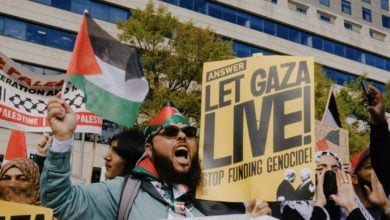In a stunning display of courage and
determination, on May 15—Nakba Day—thousands of Palestinian
refugees and their supporters stormed the borders of the Israeli
state from Syria, Lebanon and Gaza. Troops of the Israeli occupation
forces responded by opening fire, killing at least 16 people and
wounding hundreds.
In their scope and boldness, these
challenges to Israel’s denial of the Palestinian people’s right
of return were unprecedented in the 63 years since Israel expelled
750,000 Palestinians from their homeland. As has been irrefutably
documented by many Palestinian and Israeli historians, the 1948
expulsions were accomplished by means of massacres and terror.
 Read more in Richard Becker’s recent book “Palestine, Israel and the U.S. Empire” |
As of the end of 2008, there were 6.6
million Palestinian refugees and 427,000 internally displaced
persons, comprising two-thirds of all Palestinians in the world.
(Badil-“Survey of Palestinian Refugees and IDPs”,2008-9). Despite
numerous UN resolutions demanding their right to return, none have
ever been allowed back by the Israeli government. Today, millions of
Palestinians continue to live in miserable conditions in refugee
camps in Gaza, Jordan, Lebanon, Syria and the West Bank.
The Israeli Knesset (parliament)
recently passed legislation outlawing the commemoration of
al-Nakba—an Arabic term meaning “the catastrophe.” But instead
of suppressing the marking of the day, this May 15 saw the largest,
most widespread and militant protests ever on the occasion.
In addition to the border
demonstrations, there were militant protests by thousands of people
all over the occupied West Bank, the Galilee region inside the 1948
borders of the Israeli state, and in many other countries, including
the United States.
Large marches in Cairo and Alexandria
were met with heavy repression as they attempted to reach the Israeli
consulates in Egypt’s two largest cities, with 350 people reported
injured and 137 arrested. A demonstration at El Arish in the
northern Sinai region attempted to reach the Rafah border crossing
between Egypt and Gaza. Demonstrators chanted for the opening of the
border and the kicking out of the Israeli ambassador.
Jordanian security forces prevented
Palestinian demonstrators from reaching the border with Israel. The
demonstrators fought back, with reports of 14 demonstrators and 3
police injured.
Syria and Lebanon borders
Marching across hills and fields,
thousands of unarmed protesters tore down parts of the barbed
wire-covered security fence between Syria and the Israeli-occupied
Golan Heights. The Golan Heights were seized by Israel from Syria in the 1967
war at the same time it occupied the West Bank, Gaza and East
Jerusalem. In 1980, Israel illegally annexed the Golan, a move that
has never been recognized by any country in the world.
Many of the Palestinian demonstrators
came from the big Yarmouk refugee camp, which adjoins the Syrian
capital of Damascus. Hundreds of protesters made it through the fence
where they were embraced by residents of the Syrian Druze village of
Majdal Shams. The Israeli occupying forces were initially taken
off-guard, but soon responded, killing at least four and wounding
many more.
Thousands of Palestinian refugees from
all 11 camps in Lebanon came by bus and car to the border town of
Maroun al-Ras, which was the site of heavy fighting between Israeli
and Lebanese resistance forces during Israel’s 2006 invasion. Then, the Hezbollah–led forces repulsed the much better-armed
Israelis in the town, making Maroun al-Ras a lasting symbol of
resistance.
The Lebanese army sought to prevent the
refugees and their Lebanese supporters from reaching the border, but
some did. When they placed Palestinian flags on the border fence,
Israeli troops opened fire, again with live ammunition. Ten
protesters were reported killed and more than 100 wounded.
Why now?
The crucial context for this year’s
Nakba Day is the wave of rebellions sweeping the Arab world, which
have already brought down the governments of Tunisia and Egypt.
For some weeks before May 15, a call
was circulated on social media and other means calling for the day to
be the start of the “Third Intifada” (uprising). Reportedly, more
than 300,000 Palestinians and supporters have signed on to the call.
The recent Palestinian
National Reconciliation Agreement is another factor encouraging a new
upsurge in the popular resistance. A historic parallel was the April
1987 reunification of the Palestine Liberation Organization, widely
considered to have been a contributing factor to the Intifada that
began that December and lasted for several years.
The inhumane blockade of Gaza, the
relentless seizing of Palestinian land for new Israeli settlements in
the West Bank and East Jerusalem, and successive Israeli government’s
subverting of any and all negotiations are other key factors.
Israel’s intransigence was clearly a key factor in the resignation
last week of the Obama administration’s leading Middle East envoy,
George Mitchell.
Whether or not May 15 signals the start
of a protracted new intifada remains to be seen. But there can be no
question that the events of that historic day have been a blow to
both the U.S. and Israeli establishments. It will undoubtedly be a
subject of discussion when Israeli Prime Minister Benyamin Netanyahu
meets at the White House with President Obama on May 20.
The U.S. State Department’s
initial—and ludicrous—response to the events of May 15 was to
accuse Syria of being responsible.
“We are determined to defend our
borders and our sovereignty,” proclaimed Netanyahu. Translation:
“We stole this land and we will kill to hold on to it against those
we stole it from.“
Regardless of the
pronouncements by the State Department, Obama or Netanyahu, the May
15 actions have shown once again that it is the people who have the
power to change history.






